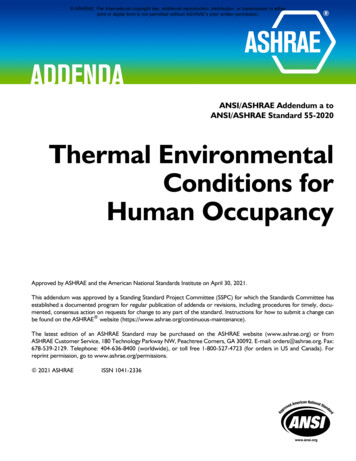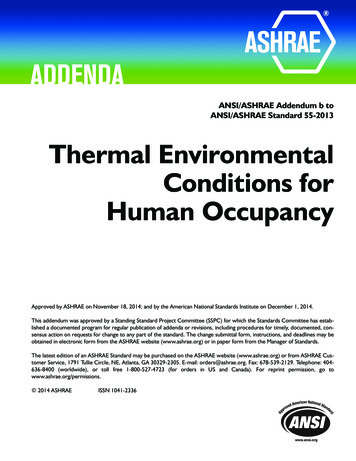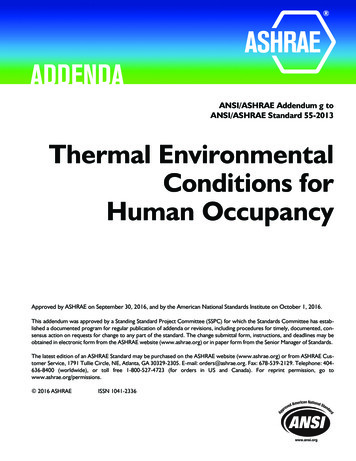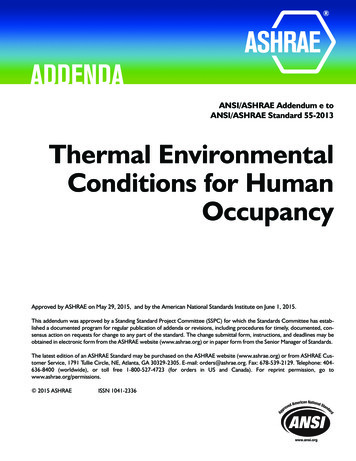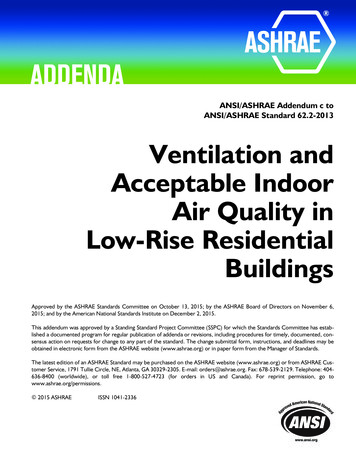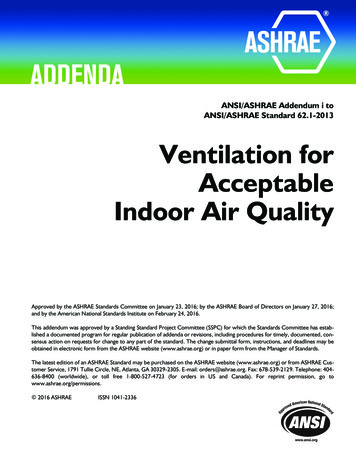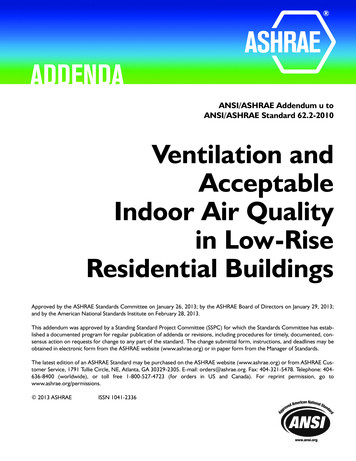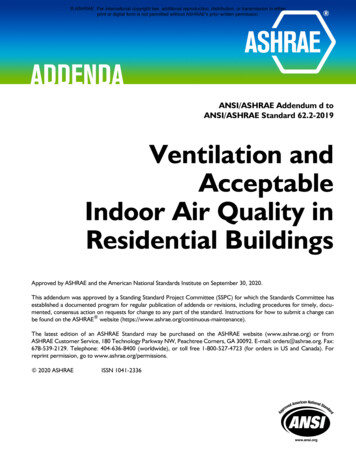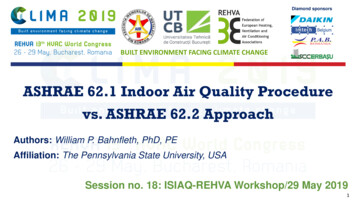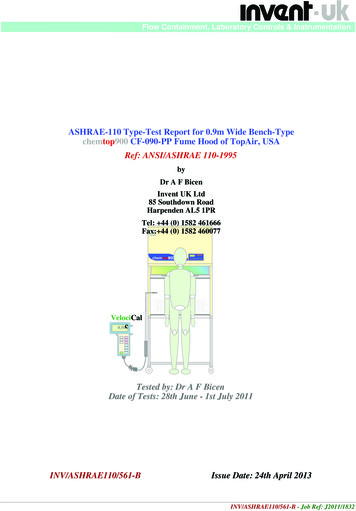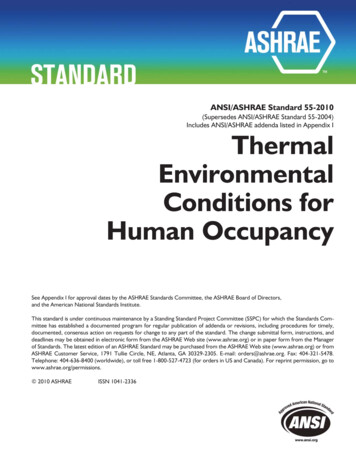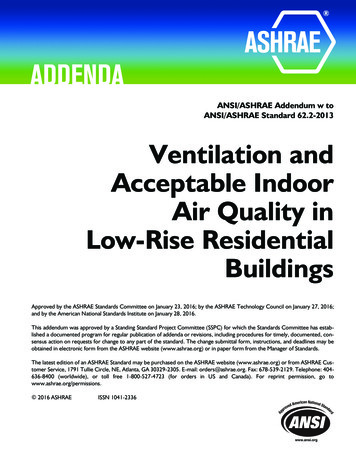
Transcription
ANSI/ASHRAE Addendum w toANSI/ASHRAE Standard 62.2-2013Ventilation andAcceptable IndoorAir Quality inLow-Rise ResidentialBuildingsApproved by the ASHRAE Standards Committee on January 23, 2016; by the ASHRAE Technology Council on January 27, 2016;and by the American National Standards Institute on January 28, 2016.This addendum was approved by a Standing Standard Project Committee (SSPC) for which the Standards Committee has established a documented program for regular publication of addenda or revisions, including procedures for timely, documented, consensus action on requests for change to any part of the standard. The change submittal form, instructions, and deadlines may beobtained in electronic form from the ASHRAE website (www.ashrae.org) or in paper form from the Manager of Standards.The latest edition of an ASHRAE Standard may be purchased on the ASHRAE website (www.ashrae.org) or from ASHRAE Customer Service, 1791 Tullie Circle, NE, Atlanta, GA 30329-2305. E-mail: orders@ashrae.org. Fax: 678-539-2129. Telephone: 404636-8400 (worldwide), or toll free 1-800-527-4723 (for orders in US and Canada). For reprint permission, go towww.ashrae.org/permissions. 2016 ASHRAEISSN 1041-2336
ASHRAE (www.ashrae.org). For personal use only. Additional reproduction, distribution,or transmission in either print or digital form is not permitted without ASHRAE's prior written permission.ASHRAE Standing Standard Project Committee 62.2Cognizant TC: 4.3, Ventilation Requirements and InfiltrationSPLS Liaison: John F. DunlapPaul Francisco*, ChairIain S. Walker*, Vice-ChairPaul H. Raymer*, SecretaryDavid A. Baylon*Terry M. Brennan*Gary CrawRoy R. Crawford*David C. Delaquila*S. Craig Drumheller*Philip W. Fairey*Henry T. GreistSanjeev K. HingoraniMark C. Jackson*David E. Jacobs*Richard J. Karg*Joseph W. Lstiburek*Michael R. Lubliner*Stephany I. Mason*Darren B. Meyers*James C. Moore, III*Wayne E. MorrisAmy B. Musser*Marc D.-M. Neufcourt*John P. Proctor*Armin RuddMax H. ShermanSarany SingerDon T. Stevens*Thomas R. Stroud*Eric D. Werling*Bruce A. Wilcox*Ted A. WilliamsAykut Yilmaz* Denotes members of voting status when the document was approved for publicationASHRAE STANDARDS COMMITTEE 2015–2016Douglass T. Reindl, ChairRita M. Harrold, Vice-ChairJames D. AsweganNiels BidstrupDonald M. BrundageJohn A. ClarkWaller S. ClementsJohn F. DunlapJames W. Earley, Jr.Keith I. EmersonSteven J. EmmerichJulie M. FergusonWalter T. GrondzikRoger L. HedrickSrinivas KatipamulaRick A. LarsonLawrence C. MarkelArsen K. MelikovMark P. ModeraCyrus H. NasseriHeather L. PlattDavid RobinPeter SimmondsDennis A. StankeWayne H. Stoppelmoor, Jr.Jack H. ZarourJulia A. Keen, BOD ExOJames K. Vallort, COStephanie C. Reiniche, Senior Manager of StandardsSPECIAL NOTEThis American National Standard (ANS) is a national voluntary consensus standard developed under the auspices of ASHRAE. Consensus is defined by theAmerican National Standards Institute (ANSI), of which ASHRAE is a member and which has approved this standard as an ANS, as “substantial agreementreached by directly and materially affected interest categories. This signifies the concurrence of more than a simple majority, but not necessarily unanimity.Consensus requires that all views and objections be considered, and that an effort be made toward their resolution.” Compliance with this standard isvoluntary until and unless a legal jurisdiction makes compliance mandatory through legislation.ASHRAE obtains consensus through participation of its national and international members, associated societies, and public review.ASHRAE Standards are prepared by a Project Committee appointed specifically for the purpose of writing the Standard. The Project CommitteeChair and Vice-Chair must be members of ASHRAE; while other committee members may or may not be ASHRAE members, all must be technicallyqualified in the subject area of the Standard. Every effort is made to balance the concerned interests on all Project Committees.The Manager of Standards of ASHRAE should be contacted for:a. interpretation of the contents of this Standard,b. participation in the next review of the Standard,c. offering constructive criticism for improving the Standard, ord. permission to reprint portions of the Standard.DISCLAIMERASHRAE uses its best efforts to promulgate Standards and Guidelines for the benefit of the public in light of available information and accepted industrypractices. However, ASHRAE does not guarantee, certify, or assure the safety or performance of any products, components, or systems tested, installed,or operated in accordance with ASHRAE’s Standards or Guidelines or that any tests conducted under its Standards or Guidelines will be nonhazardous orfree from risk.ASHRAE INDUSTRIAL ADVERTISING POLICY ON STANDARDSASHRAE Standards and Guidelines are established to assist industry and the public by offering a uniform method of testing for rating purposes, by suggestingsafe practices in designing and installing equipment, by providing proper definitions of this equipment, and by providing other information that may serveto guide the industry. The creation of ASHRAE Standards and Guidelines is determined by the need for them, and conformance to them is completelyvoluntary.In referring to this Standard or Guideline and in marking of equipment and in advertising, no claim shall be made, either stated or implied, that theproduct has been approved by ASHRAE.ASHRAE is a registered trademark of the American Society of Heating, Refrigerating and Air-Conditioning Engineers, Inc.ANSI is a registered trademark of the American National Standards Institute.
ASHRAE (www.ashrae.org). For personal use only. Additional reproduction, distribution,or transmission in either print or digital form is not permitted without ASHRAE's prior written permission.(This foreword is not part of this standard. It is merelyinformative and does not contain requirements necessaryfor conformance to the standard. It has not been processed according to the ANSI requirements for a standardand may contain material that has not been subject topublic review or a consensus process. Unresolved objectors on informative material are not offered the right toappeal at ASHRAE or ANSI.)8.9.10.FOREWORDThis addendum updates the normative references in anticipation of publishing the 2016 edition of Standard 62.2.Note: In this addendum, changes to the current standardare indicated in the text by underlining (for additions) andstrikethrough (for deletions) unless the instructions specifically mention some other means of indicating the changes.11.Addendum w to Standard 62.2-201313.12.Revise Section 10 as shown.10. REFERENCES1.2.3.4.5.6.7.ANSI/ASTM E779-10. Standard Test Method for Determining Air Leakage Rate by Fan Pressurization. ASTMInternational, West Conshohocken, PA.CAN/CGSB 149.10-M86. Determination for the Airtightness of Building Envelopes by the Fan Depressurization Method. Canadian General Standard Board,Gatineau, Quebec, Canada.RESNET. 20132011. Mortgage Industry National HomeEnergy Rating Systems Standard. Residential EnergyServices Network.ASHRAE Guideline 24-20152008, Ventilation andIndoor Air Quality in Low-Rise Residential Buildings.ASHRAE, Atlanta, GA.NFPA 54-20152002/ANSI Z223.1-20152002, NationalFuel Gas Code. National Fire Protection Associationand American Gas Association, Quincy, MA, andWashington, DC.NFPA 31-20112006, Standard for the Installation of OilBurning Equipment. National Fire Protection Association, Quincy, MA.NFPA 211-20132006, Standard for Chimneys, Fireplaces, Vents, and Solid-Fuel Burning Appliances.National Fire Protection Association, Quincy, MA.ANSI/ASHRAE Addendum w to ANSI/ASHRAE Standard 62.2-201314.15.16.17.18.19.20.California Energy Commission (2013). California Title24 Standards, Reference Appendix RA3.ANSI/ASTM E1554/E1554M-1307, Standard Test Methods for Determining External Air Leakage of Air Distribution Systems by Fan Pressurization. ASTMInternational, West Conshohocken, PA.ANSI/ASHRAE Standard 52.2-20122007 with 2015Supplement, Method of Testing General VentilationAir-Cleaning Devices for Removal Efficiency by Particle Size. ASHRAE, Atlanta, GA.AHRI Standard 680-2009, Performance Rating of Residential Air Filter Equipment. Air-Conditioning, Heating, and Refrigerating Institute, Arlington, VA.NFPA 720-20152009, Standard for the Installation ofCarbon Monoxide (CO) Detection and Warning Equipment. National Fire Protection Association, Quincy,MA.ANSI/ASHRAE Standard 51-1999/AMCA Standard210-99, Laboratory Methods of Testing Fans for Aerodynamic Performance Rating. American Air Movementand Control Association International, Inc., ArlingtonHeights, IL.NSI/AMCA Standard 300-1405, Reverberant RoomMethod for Sound Testing of Fans. American AirMovement and Control Association International, Inc.,Arlington Heights, IL.HVI 915-201506, Loudness Testing and Rating Procedure Procedure for Loudness Rating of Residential FanProducts. Home Ventilating Institute, ArlingtonHeights, IL.HVI 916-201309, Air Flow Test Procedure. Home Ventilating Institute, Arlington Heights, IL.HVI 920-201509, Product Performance CertificationProcedure Including Verification and Challenge. HomeVentilating Institute, Arlington Heights, IL.ANSI/ASHRAE Standard 62.1-20132010, Ventilationfor Acceptable Indoor Air Quality. ASHRAE, Atlanta,GA.ANSI/ASTM E1827-1107, Standard Test Methods forDetermining Airtightness of Buildings Using an OrificeBlower Door, ASTM International, West Conshohocken, PAANSI/NAHB Z765-2003, American National Standardfor Single-Family Residential Buildings Square Footage Method for Calculating. National Association ofHome Builders, Washington, DC.1
ASHRAE (www.ashrae.org). For personal use only. Additional reproduction, distribution,or transmission in either print or digital form is not permitted without ASHRAE's prior written permission.
ASHRAE (www.ashrae.org). For personal use only. Additional reproduction, distribution,or transmission in either print or digital form is not permitted without ASHRAE's prior written permission.POLICY STATEMENT DEFINING ASHRAE’S CONCERNFOR THE ENVIRONMENTAL IMPACT OF ITS ACTIVITIESASHRAE is concerned with the impact of its members’ activities on both the indoor and outdoor environment. ASHRAE’s members willstrive to minimize any possible deleterious effect on the indoor and outdoor environment of the systems and components in theirresponsibility while maximizing the beneficial effects these systems provide, consistent with accepted standards and the practical state ofthe art.ASHRAE’s short-range goal is to ensure that the systems and components within its scope do not impact the indoor and outdoorenvironment to a greater extent than specified by the standards and guidelines as established by itself and other responsible bodies.As an ongoing goal, ASHRAE will, through its Standards Committee and extensive technical committee structure, continue togenerate up-to-date standards and guidelines where appropriate and adopt, recommend, and promote those new and revised standardsdeveloped by other responsible organizations.Through its Handbook, appropriate chapters will contain up-to-date standards and design considerations as the material issystematically revised.ASHRAE will take the lead with respect to dissemination of environmental information of its primary interest and will seek out anddisseminate information from other responsible organizations that is pertinent, as guides to updating standards and guidelines.The effects of the design and selection of equipment and systems will be considered within the scope of the system’s intended useand expected misuse. The disposal of hazardous materials, if any, will also be considered.ASHRAE’s primary concern for environmental impact will be at the site where equipment within ASHRAE’s scope operates.However, energy source selection and the possible environmental impact due to the energy source and energy transportation will beconsidered where possible. Recommendations concerning energy source selection should be made by its members.
ASHRAE · 1791 Tullie Circle NE · Atlanta, GA 30329 · www.ashrae.org2/16
02.02.2016 · ANSI/ASHRAE Standard 62.2-2013 Ventilation and Acceptable Indoor Air Quality in Low-Rise Residential Buildings Approved by the ASHRAE Standards Committee on January 23, 2016; by the ASHRAE Technology Council on January 27, 2016; and by the American National Standards Institute on January 28, 2016. This addendum was approved by a Standing Standard Project Committee (SSPC)

